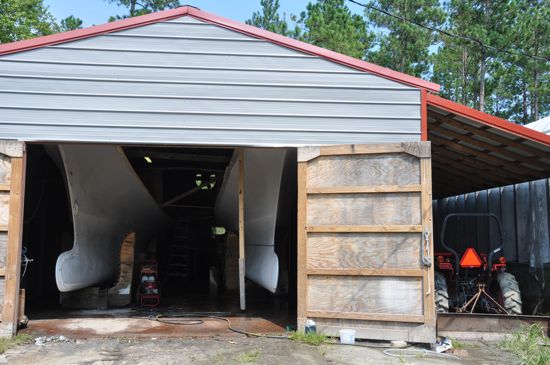It's Saturday April 20, 2024
September 7, 2011
Aweek after Hurricane Irene hit, it became apparent that the shores of the Bay River were struck especially hard. It wasn’t the winds — at least not directly — that did all the damage. It was mainly the water.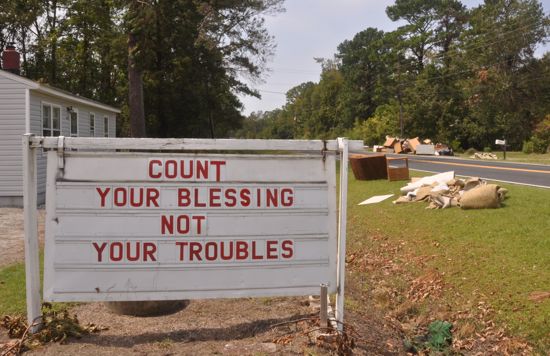 On Hwy 304 in Maribel at the Church of God of Prophecy. Many piles of house debris or fallen limbs lined the highway. The piles grew more frequent further up Hwy 304 in Lowland and Hobucken and up Hwy 307 in Vandemere.
On Hwy 304 in Maribel at the Church of God of Prophecy. Many piles of house debris or fallen limbs lined the highway. The piles grew more frequent further up Hwy 304 in Lowland and Hobucken and up Hwy 307 in Vandemere.That was the case in Vandemere, on the Bay River’s north shore. Many homes flooded. Some we spoke to said that relatives were trapped on second floors of their homes until Irene’s storm surge ebbed.
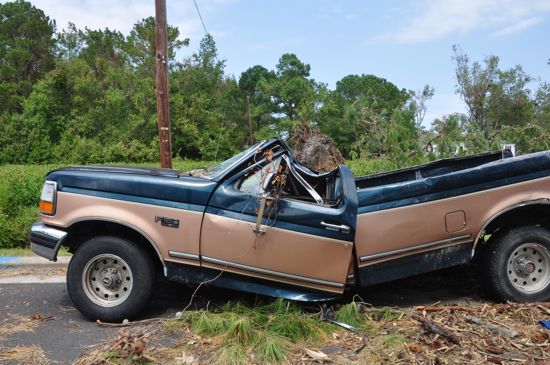 While many homes in Vandemere flooded, many cars were saved by parking on the town’s high spot, a field across from the volunteer fire department station. One person thought, parked on Hiway 304 and while the truck stayed dry, it was crushed when a tree fell on it.
While many homes in Vandemere flooded, many cars were saved by parking on the town’s high spot, a field across from the volunteer fire department station. One person thought, parked on Hiway 304 and while the truck stayed dry, it was crushed when a tree fell on it.As elsewhere in Pamlico County, no one was killed in Vandemere. But Irene did leave many homes wet, people homeless and lots of work ahead.
Ahead, photos of Camp Vandemere which was inundated during the hurricane, and a bit down the road, boat designer Graham Byrnes’ B&B Yachts and the catamaran hulls that proved they do indeed float.
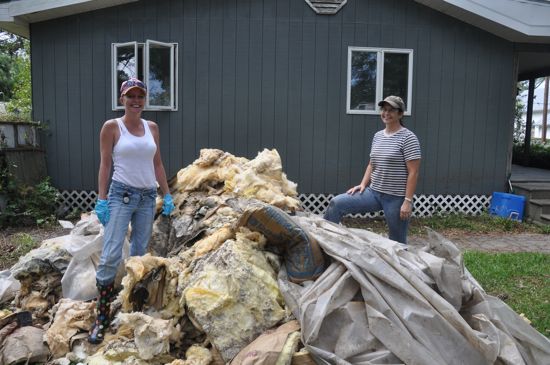 On Friday, 7 days after Irene hit, Dawn Skurry and Beth Bucksot stand on the pile of insulation they pulled out from under the Vandemere home of Beth’s parents, Carla and Graham Byrnes. They wore white haz mat suits for the job earlier in the week. (Dawn’s polka-dot boots have been on her feet for days, she says.) Beth Bucksot says that listening or reading the media, she gets the sense that people who haven’t seen her area “don’t have a clue” about “how extensive the damage is.”Camp Vandemere.
On Friday, 7 days after Irene hit, Dawn Skurry and Beth Bucksot stand on the pile of insulation they pulled out from under the Vandemere home of Beth’s parents, Carla and Graham Byrnes. They wore white haz mat suits for the job earlier in the week. (Dawn’s polka-dot boots have been on her feet for days, she says.) Beth Bucksot says that listening or reading the media, she gets the sense that people who haven’t seen her area “don’t have a clue” about “how extensive the damage is.”Camp Vandemere.Camp Vandemere was swamped. Look out from the buildings there and the waters of the Bay River seem almost level with the grass — they’re actually a few feet lower. During Irene, the waters were chest high when they got to the buildings. Windows were punched out in some buildings. Another moved off of its footings.
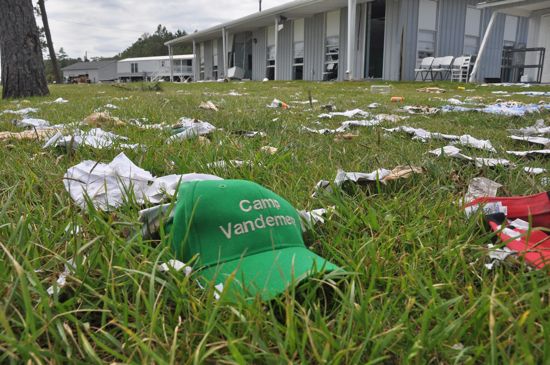 Camp Vandemere, whose lawn is just a few feet above the Bay River’s normal height, had storm surge waters rush through and destroy buildings. One structure was even moved several feet off its foundation. Each summer, 800-1,000 campers go to the camp which his run by the Free Will Baptist Church of eastern NC.
Camp Vandemere, whose lawn is just a few feet above the Bay River’s normal height, had storm surge waters rush through and destroy buildings. One structure was even moved several feet off its foundation. Each summer, 800-1,000 campers go to the camp which his run by the Free Will Baptist Church of eastern NC.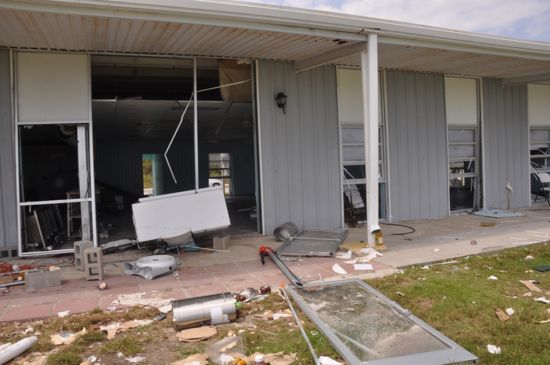 The dining hall at Camp Vandemere.
The dining hall at Camp Vandemere.The camp is run by the Free Will Baptist Church of eastern North Carolina. The camp’s director Rick Price said there had been some talk in recent years about elevating the buildings. He said he thinks that as the camp rebuilds, the structures will be higher.
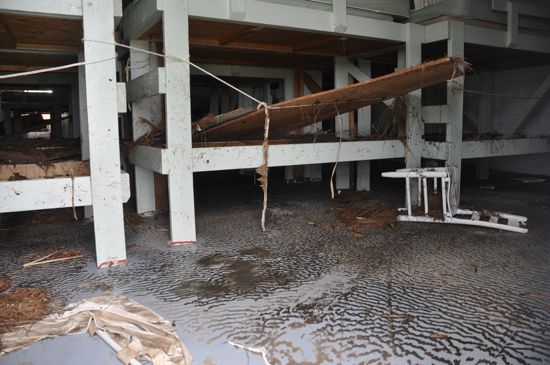 The dormitory at Camp Vandemere where 80 to 100 campers would sleep. Camp director Rick Price says that in advance of Hurricane Irene, he had the bunkbeds lashed together so that as a mass they’d stay together. Water was chest high in that and other buildings. The receding water left a sandbar effect on the floor.
The dormitory at Camp Vandemere where 80 to 100 campers would sleep. Camp director Rick Price says that in advance of Hurricane Irene, he had the bunkbeds lashed together so that as a mass they’d stay together. Water was chest high in that and other buildings. The receding water left a sandbar effect on the floor.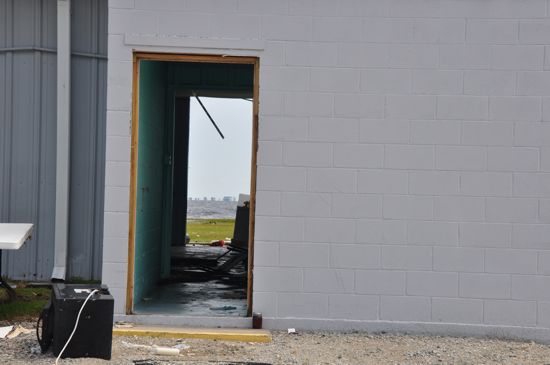 6 days after Hurricane Irene hit, a view through a hallway looking from the parking lot to Camp Vandemere’s front lawn. That darker band above the grass line, is the Bay River. The camp’s director, Rick Price says there had been discussion for some time about elevating the buildings. The Free Will Baptist Church will likely be doing that now, he says.
6 days after Hurricane Irene hit, a view through a hallway looking from the parking lot to Camp Vandemere’s front lawn. That darker band above the grass line, is the Bay River. The camp’s director, Rick Price says there had been discussion for some time about elevating the buildings. The Free Will Baptist Church will likely be doing that now, he says.First though, there’s the cleanup to be done. About a hundred volunteers are expected the second weekend in September.
[page]
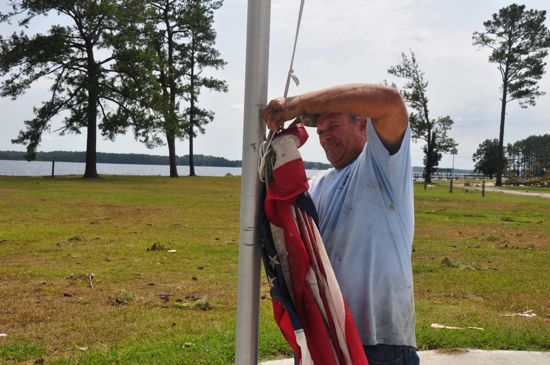 On Friday, Rick Price went to the flagpoles on the lawn of the camp to hang out still-damp flags. The flag halyard was tough to loosen, having been stressed and tightened by the winds in Hurricane Irene.
On Friday, Rick Price went to the flagpoles on the lawn of the camp to hang out still-damp flags. The flag halyard was tough to loosen, having been stressed and tightened by the winds in Hurricane Irene.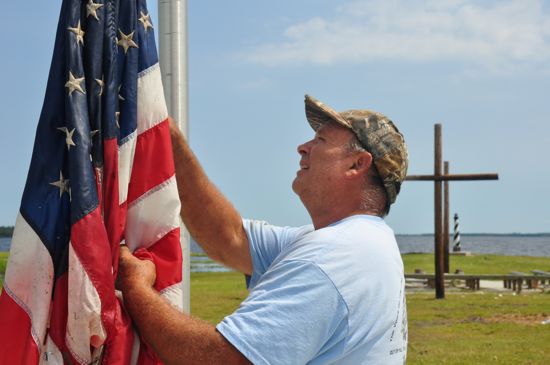 The knot untied… the flag was raised.
The knot untied… the flag was raised.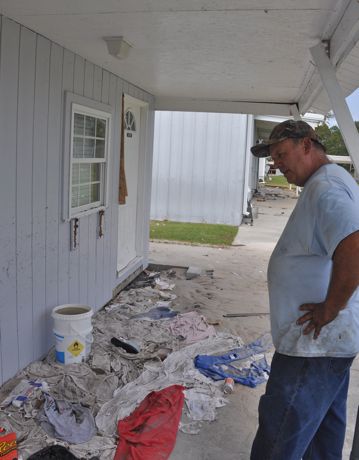 Rick Price in front of the camp’s concession stand, which was pushed back several feet by the force of the storm surge and wind.
Rick Price in front of the camp’s concession stand, which was pushed back several feet by the force of the storm surge and wind.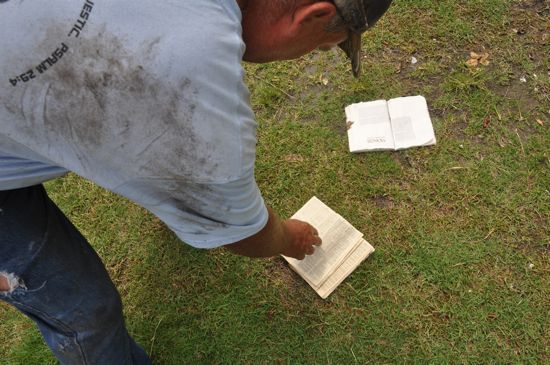 Rick Price, director of Camp Vandemere for the past four years, reaches down to one of many open bibles strewn about the property. He says the Free Will Baptist Church of Eastern NC, which runs the camp, will rebuild, and higher than before.
Rick Price, director of Camp Vandemere for the past four years, reaches down to one of many open bibles strewn about the property. He says the Free Will Baptist Church of Eastern NC, which runs the camp, will rebuild, and higher than before.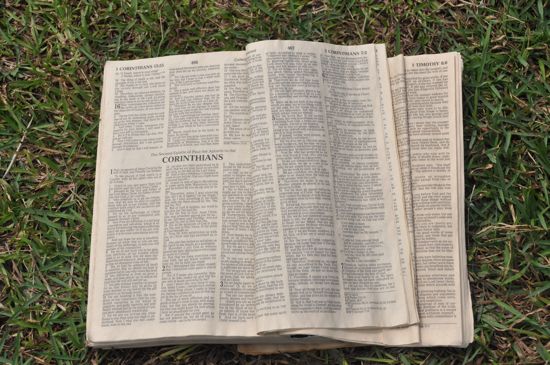 A Bible, opened to Corinthians, on the lawn of the Camp Vandemere, operated by the Free Will Baptist Church of Eastern NC.
A Bible, opened to Corinthians, on the lawn of the Camp Vandemere, operated by the Free Will Baptist Church of Eastern NC.Ahead, B&B Yachts [page]
B&B YachtsVandemere is where naval architect Graham Byrnes lives with his wife Carla. Together they run B&B Yachts. Hurricane Irene’s storm surge came within an inch and a half of their home’s floor boards — duct work and insulation had to be torn out but on the whole, their home was okay.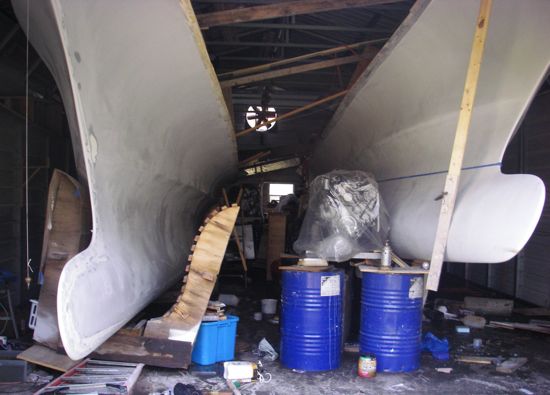 The scene at the B&B Yachts shed, a day after Irene pushed the hulls being built for a 45-foot catamaran off their cradles. (Alan Stewart photo.)
The scene at the B&B Yachts shed, a day after Irene pushed the hulls being built for a 45-foot catamaran off their cradles. (Alan Stewart photo.)Irene made herself felt a bit more at the B&B shop a few miles away, near the banks of the Bay River, where Graham’s been building a 45-foot-long power catamaran for the past year. Graham and Carla’s daughter, Beth Bucksot, jokes that Irene gave the two 45-foot Airex hulls an early sea trial.
When more than four feet of water got in to the boat building shed, the hulls rocked upward and sideways in their cradles. The hulls are not yet attached and one was left at a 30 degree angle, Graham says. It took two days to get the two hulls true and level again.
It took two days to get the hulls — with their distinctive bulb bows — sitting level and flat in their cradles after Hurricane Irene floated them askew. This photo was taken on a visit to B&B Yachts 6 days after Irene.Graham says one preparation strategy for Hurricane Irene might’ve been to drill holes in the hull so that water could get in and keep it from being buoyant. But he was wary of putting otherwise unnecessary holes in a hull.
Like others in Pamlico County, Hurricane Irene’s floodwaters took him by surprise. The circumnavigator and Australia native and veteran of many other Pamlico County hurricanes says he just didn’t expect as much storm surge.
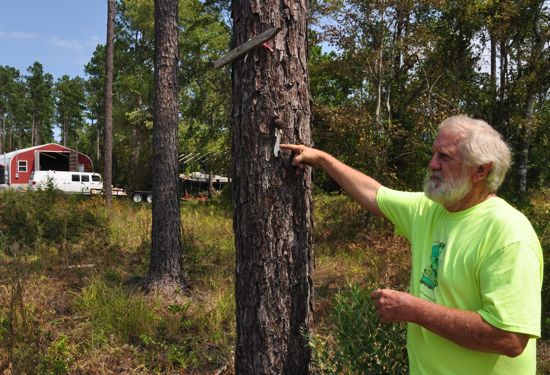 The water got to just under the 9-1/2 foot mark on the tree outside Graham Byrnes’ B&B Yachts yard outside Vandemere.
The water got to just under the 9-1/2 foot mark on the tree outside Graham Byrnes’ B&B Yachts yard outside Vandemere.In a bit of untimeliness, the two engines for the catamaran arrived the week before Hurricane Irene. That left Graham with the challenge of keeping them high and dry. He put each on a pair of metal drums. To keep the drums from floating, he drilled holes in them. Engines mounted on drums stayed in place and high and dry during the worst of Irene.
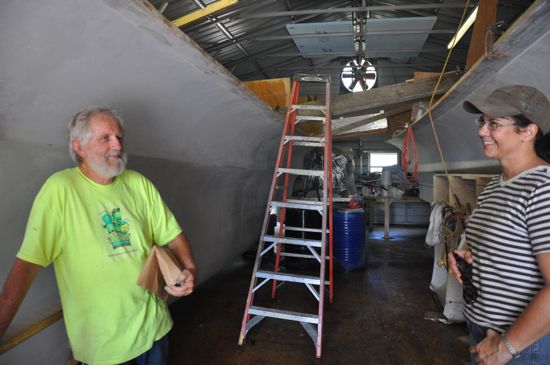 Graham Byrnes and his daughter, Beth Bucksot. Beth says that Irene gave the power cat hulls their sea trial. Graham’s worked for a year on the boat, which he’s building for a customer.
Graham Byrnes and his daughter, Beth Bucksot. Beth says that Irene gave the power cat hulls their sea trial. Graham’s worked for a year on the boat, which he’s building for a customer.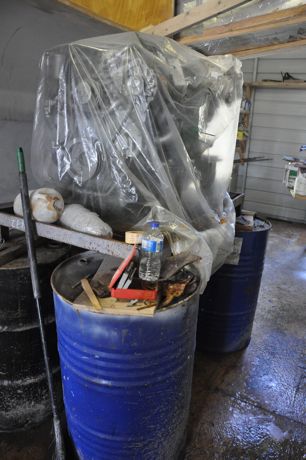 Hurricane Irene engine mounts at B&B Yachts. Metal drums with holes in them— to render them non-buoyant — kept the engines away from water. It’s what you do when engines are delivered a week before a hurricane.
Hurricane Irene engine mounts at B&B Yachts. Metal drums with holes in them— to render them non-buoyant — kept the engines away from water. It’s what you do when engines are delivered a week before a hurricane.Faring less well was his computer. It went under water and with it, notes from the last month as he fine-tuned the catamaran’s design. “I was slack,” Graham says, about backing up the data. So far, he’s tried a rinse, an alcohol soak and was going to try a new battery.
[page]
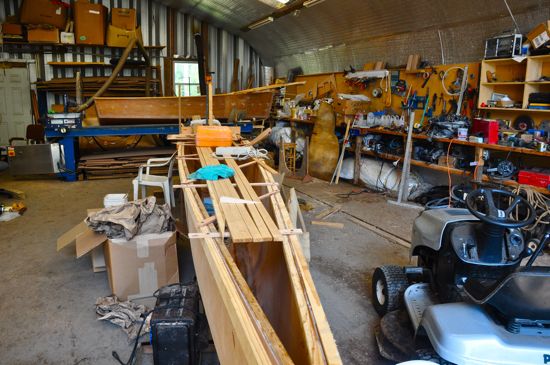 Graham’s other workshop, where water also got in. While not enough to float the boats, it did damage the lower-lying saw that cuts wood for Graham Byrnes’ boat kits.
Graham’s other workshop, where water also got in. While not enough to float the boats, it did damage the lower-lying saw that cuts wood for Graham Byrnes’ boat kits.In an adjacent workshop, where a saw cuts pieces of wood for Graham’s mail-order boat kits, the waters got in to the electronics that were on the floor.
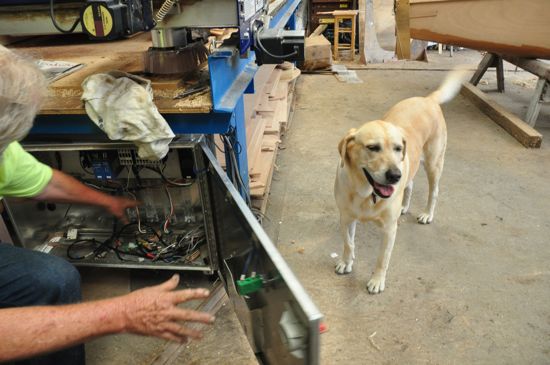 Underwater in Irene: the electronics for the saw. He’s working on getting it up and running again.
Underwater in Irene: the electronics for the saw. He’s working on getting it up and running again.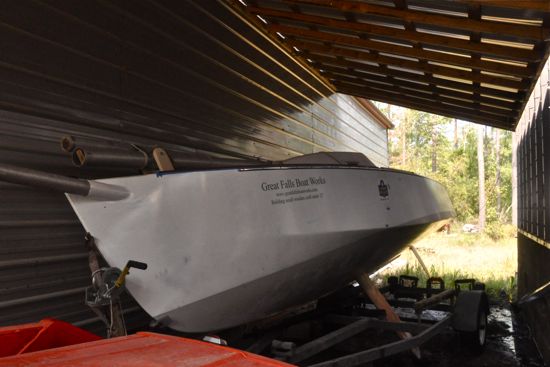 Not so well to weather, right now. . Pre-Irene, he stored his own boat, a Southern Skimmer that he designed and built, on a trailer in a side boat shed off of his bigger workshop. The centerboard’s proximity to muddy ground complicates righting it. Graham says he’ll use some come-alongs to set things right.
Not so well to weather, right now. . Pre-Irene, he stored his own boat, a Southern Skimmer that he designed and built, on a trailer in a side boat shed off of his bigger workshop. The centerboard’s proximity to muddy ground complicates righting it. Graham says he’ll use some come-alongs to set things right.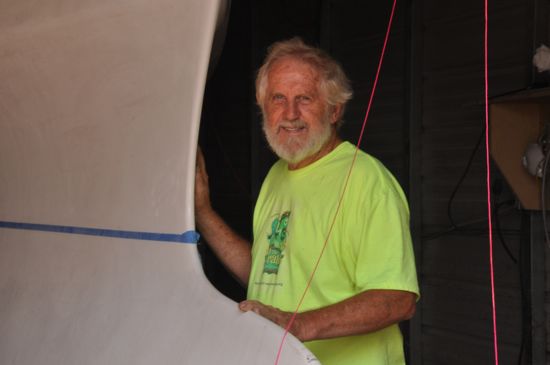 Graham Byrnes and one of the wave-piercing bulb bows of the 45-foot power catamaran that he’s worked on for the past year. Built to do 25 knots, it got an early sea trial in Irene. As for a launch date, he says he’s “hoping to catch the ‘Irene’ of next year.”
Graham Byrnes and one of the wave-piercing bulb bows of the 45-foot power catamaran that he’s worked on for the past year. Built to do 25 knots, it got an early sea trial in Irene. As for a launch date, he says he’s “hoping to catch the ‘Irene’ of next year.”
